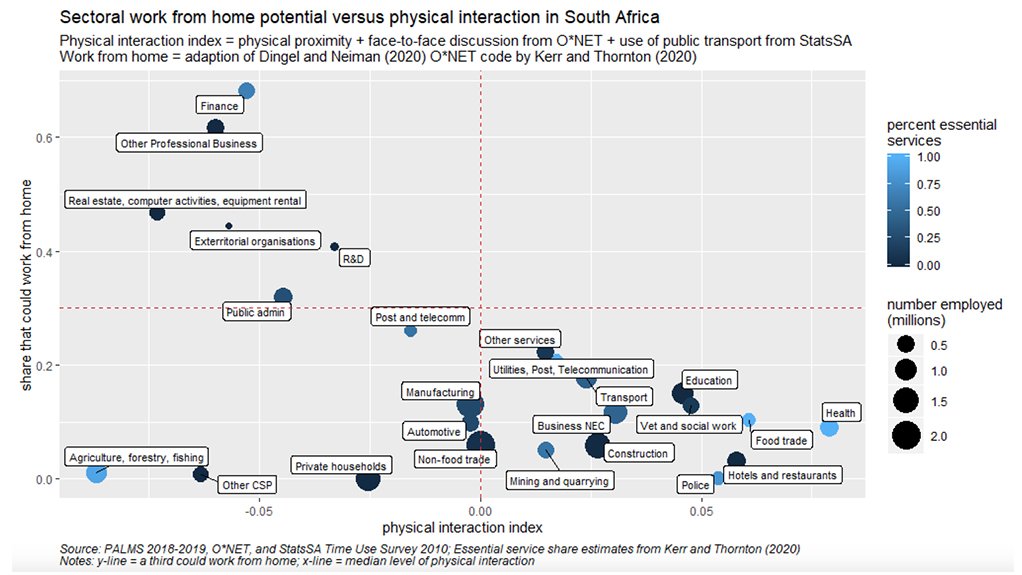New index ranks physical-interaction aspect of Covid-19 transmission risk across occupations


Sectoral work from home potential versus physical interaction in South Africa
Photo by Development Policy Research Unit
A new index has been created to provide an empirical basis for ranking the physical-interaction dimension of the Covid-19 transmission risk for various occupations in South Africa – a tool that could help guide policymakers in evaluating which sectors place workers at a higher or lower risk of contracting the virus as lockdown measures are eased.
Developed by academics at the University of Cape Town’s Development Policy Research Unit the Physical Interaction Index takes account of the role that human proximity and contact plays in the spread of Covid-19 and uses pre-pandemic data to measure that risk across various occupations.
In a working paper titled ‘Jobs and Covid-19: Measuring Work-Related Physical Interaction’ and authored by Haroon Bhorat, Amy Thornton, Tim Köhler and Morné Oosthuizen it is acknowledged that physical interaction is but one dimension of the overall Covid-19 transmission risk. Other factors include the link to infection rates per age, how easily the work environment can be adapted to safety protocols, or the capacity of the public health system at a given point in time.
Given that the virus spreads when uninfected individuals come into contact with respiratory droplets from an infected person who coughs or sneezes, however, the authors argue that it is important to understand the level of physical interaction people have on the job or on their way to work.
To assess this risk, the paper seeks to offer evidence-based insight into how physical human interaction was distributed across different sectors in South Africa just before the pandemic hit.
To do this, an index of physical interaction for different occupations has been created, drawing on the Occupational Information Network, an American survey of detailed occupational information from office sharing to the level of face-to-face engagements, as well as information on physical interaction in work travel garnered from Statistics South Africa’s latest Time Use Survey. The scores for each occupation are then merged with South African labour market data in the Post-Apartheid Labour Market Series version of the Quarterly Labour Force Surveys for 2018 and first two quarters of 2019.
The index, which varies between zero and one and increases with the level of physical interaction, includes three equally weighted dimensions:
- Physical proximity, scored using options that range from beyond 30 m to very close or nearly touching;
- Face-to-face discussions, which again varies from never to every day; and
- Use of public transport, which is based on results from Statistics South Africa’s latest Time Use Survey.
The three components are then combined for a specific occupation at the four-digit level of occupation codes using the 2003 South African Standard Classification of Occupations.
The formula has been tested across various occupations to rank both physical interactions and the ability to work from home, the latter of which was estimated for South Africa by Thornton and Andrew Kerr, who works for DataFirst at the University of Cape Town.
The initial results point to the health sector having the highest score for physical interaction, closely followed by the food trade, as well as hotels and restaurants.
By contrast, the finance sector has a low level of physical interaction and the highest share of workers who could work from home. “This suggests that working from home would be a good strategy to keep transmission risk low for this group.”
Manufacturing, the automotive trade sector, and non-food trade have median levels of physical interaction, but rank very low on an ability to work from home.
“We believe our index is a useful method for providing some indication of where Covid-19 transmission risk may be highest because of its alignment with physical interaction,” the authors state.
However, they also stress that index does not measure transmission risk, itself, as other aspects may come into play.
“For example, it may be harder to implement work safety protocols in a private household than a restaurant. These other dimensions may ultimately reorder which occupations and sectors have a higher transmission risk.”
Nevertheless, physical interaction is a key factor in spreading Covid19. “So we think providing some data on this topic may be helpful when choosing the composition of sectors to phase back to work as the lockdown is eased.”
Comments
Press Office
Announcements
What's On
Subscribe to improve your user experience...
Option 1 (equivalent of R125 a month):
Receive a weekly copy of Creamer Media's Engineering News & Mining Weekly magazine
(print copy for those in South Africa and e-magazine for those outside of South Africa)
Receive daily email newsletters
Access to full search results
Access archive of magazine back copies
Access to Projects in Progress
Access to ONE Research Report of your choice in PDF format
Option 2 (equivalent of R375 a month):
All benefits from Option 1
PLUS
Access to Creamer Media's Research Channel Africa for ALL Research Reports, in PDF format, on various industrial and mining sectors
including Electricity; Water; Energy Transition; Hydrogen; Roads, Rail and Ports; Coal; Gold; Platinum; Battery Metals; etc.
Already a subscriber?
Forgotten your password?
Receive weekly copy of Creamer Media's Engineering News & Mining Weekly magazine (print copy for those in South Africa and e-magazine for those outside of South Africa)
➕
Recieve daily email newsletters
➕
Access to full search results
➕
Access archive of magazine back copies
➕
Access to Projects in Progress
➕
Access to ONE Research Report of your choice in PDF format
RESEARCH CHANNEL AFRICA
R4500 (equivalent of R375 a month)
SUBSCRIBEAll benefits from Option 1
➕
Access to Creamer Media's Research Channel Africa for ALL Research Reports on various industrial and mining sectors, in PDF format, including on:
Electricity
➕
Water
➕
Energy Transition
➕
Hydrogen
➕
Roads, Rail and Ports
➕
Coal
➕
Gold
➕
Platinum
➕
Battery Metals
➕
etc.
Receive all benefits from Option 1 or Option 2 delivered to numerous people at your company
➕
Multiple User names and Passwords for simultaneous log-ins
➕
Intranet integration access to all in your organisation



















